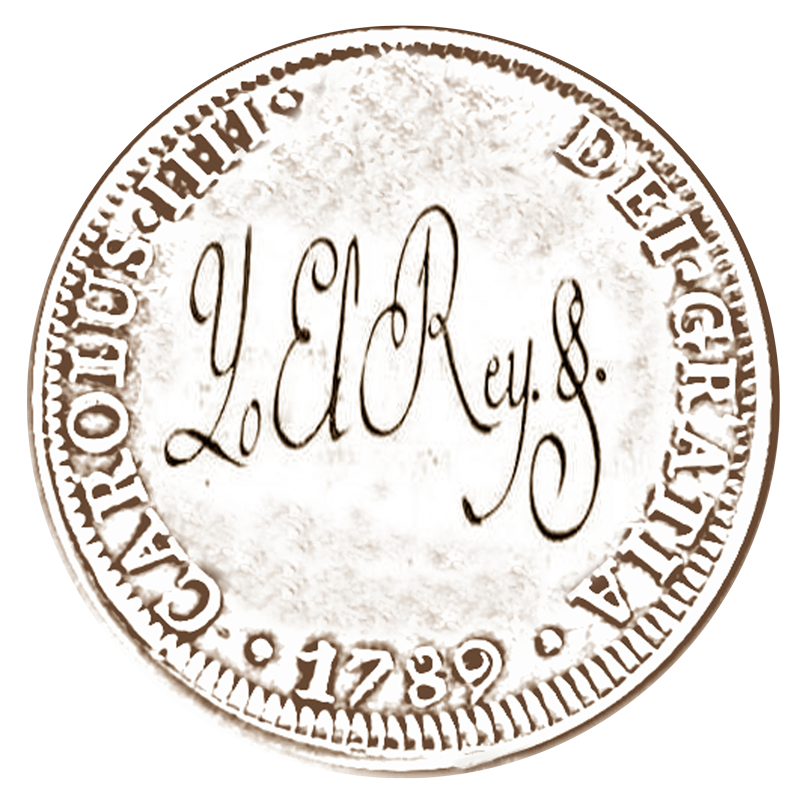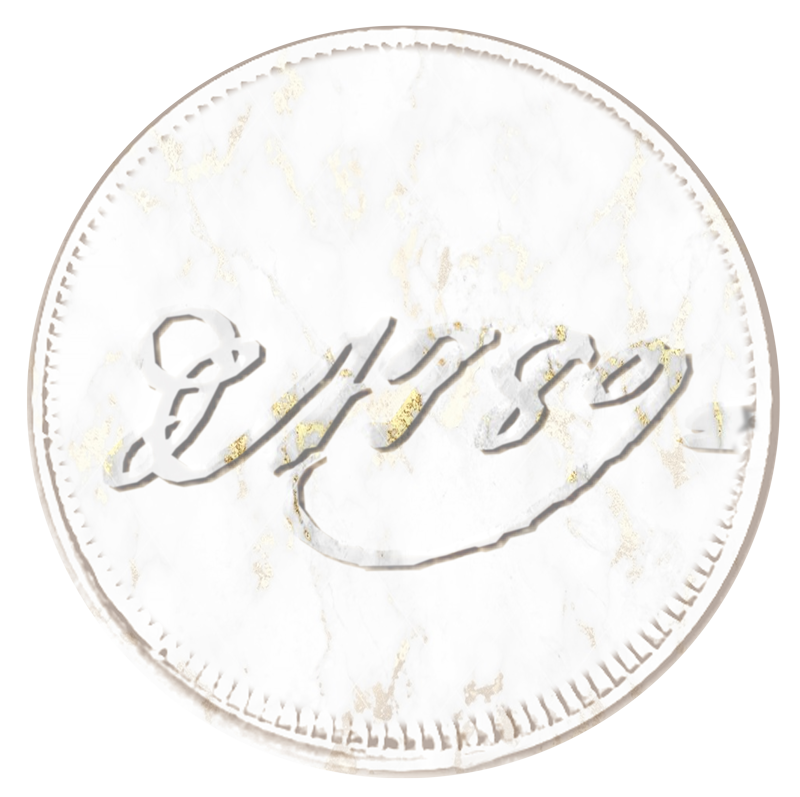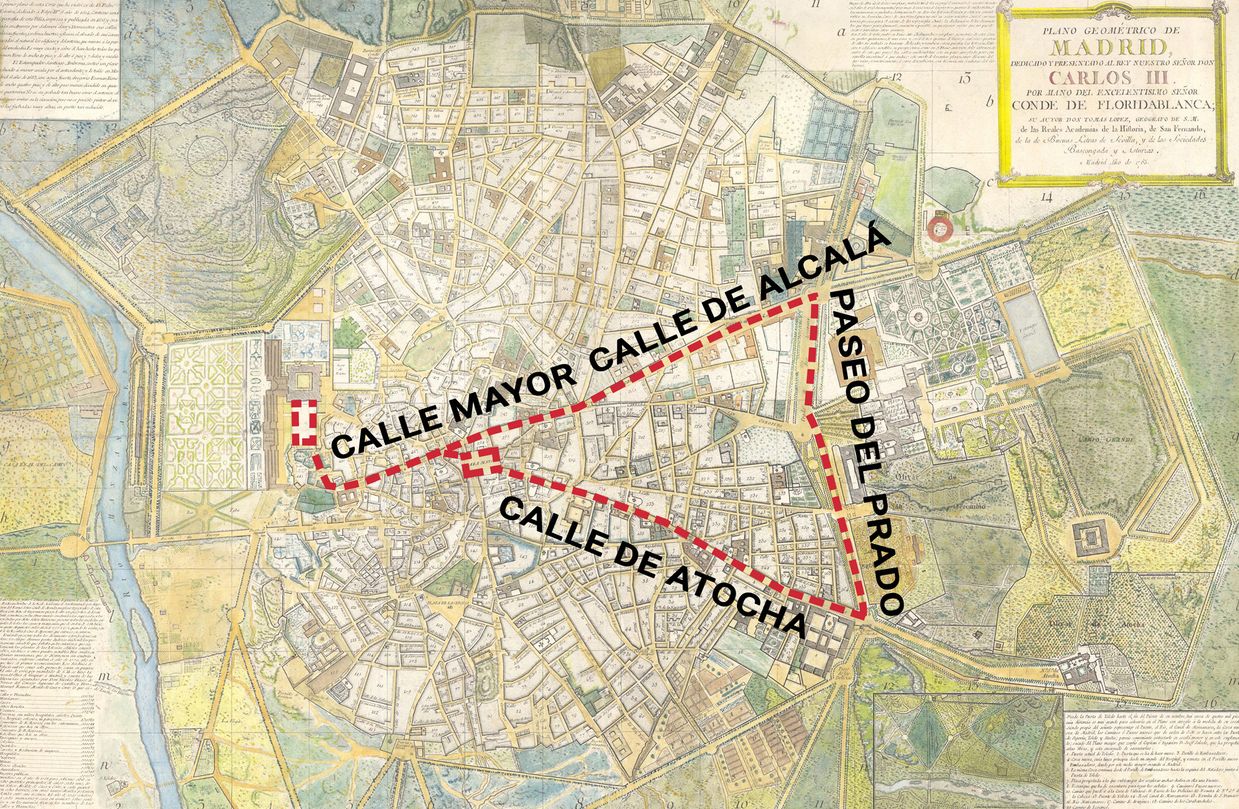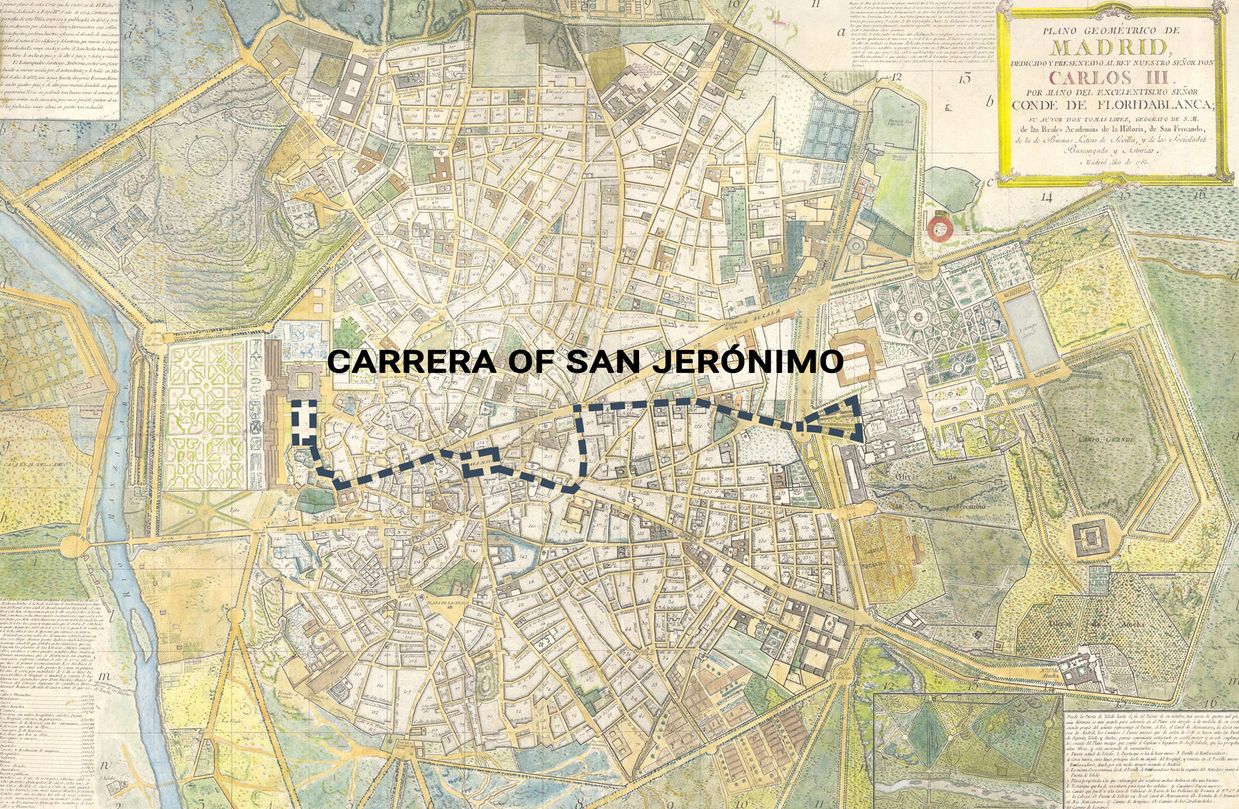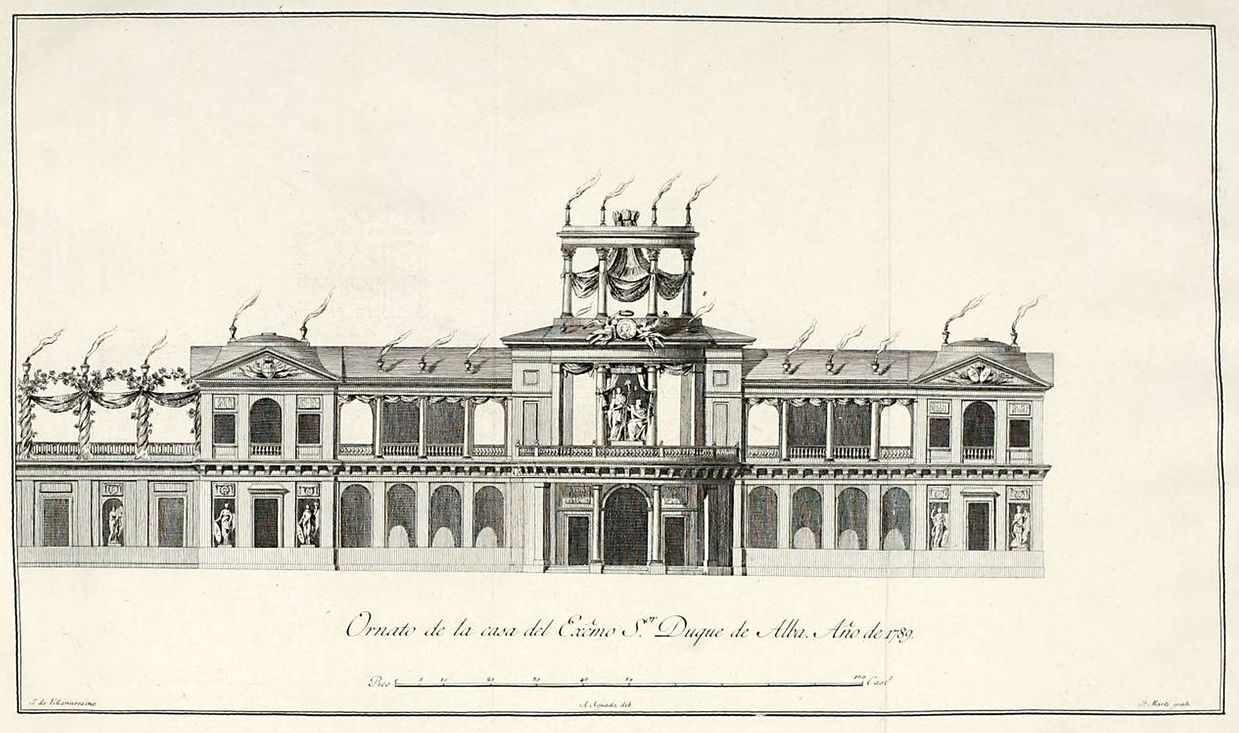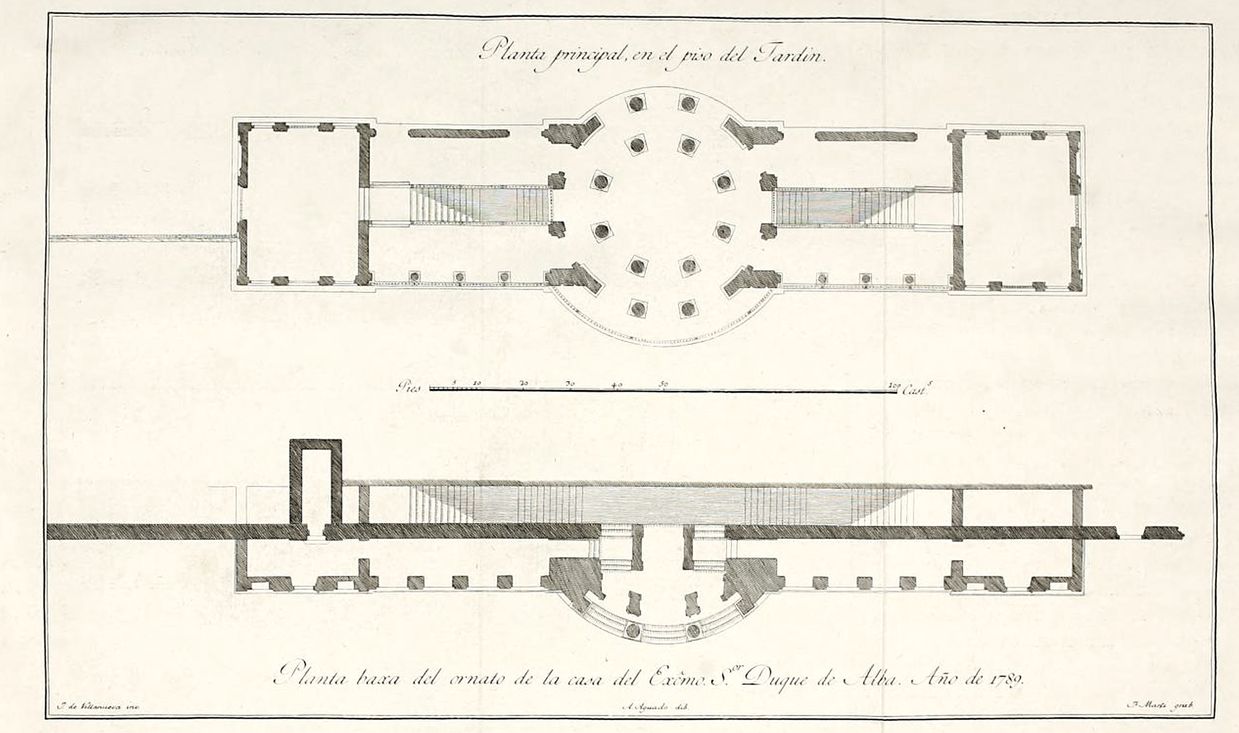“Good architecture”
Juan de Villanueva’s ephemeral construction for the proclamation of Carlos IV in Madrid, 1789
Victoria Soto Caba & Isabel Solís Alcudia
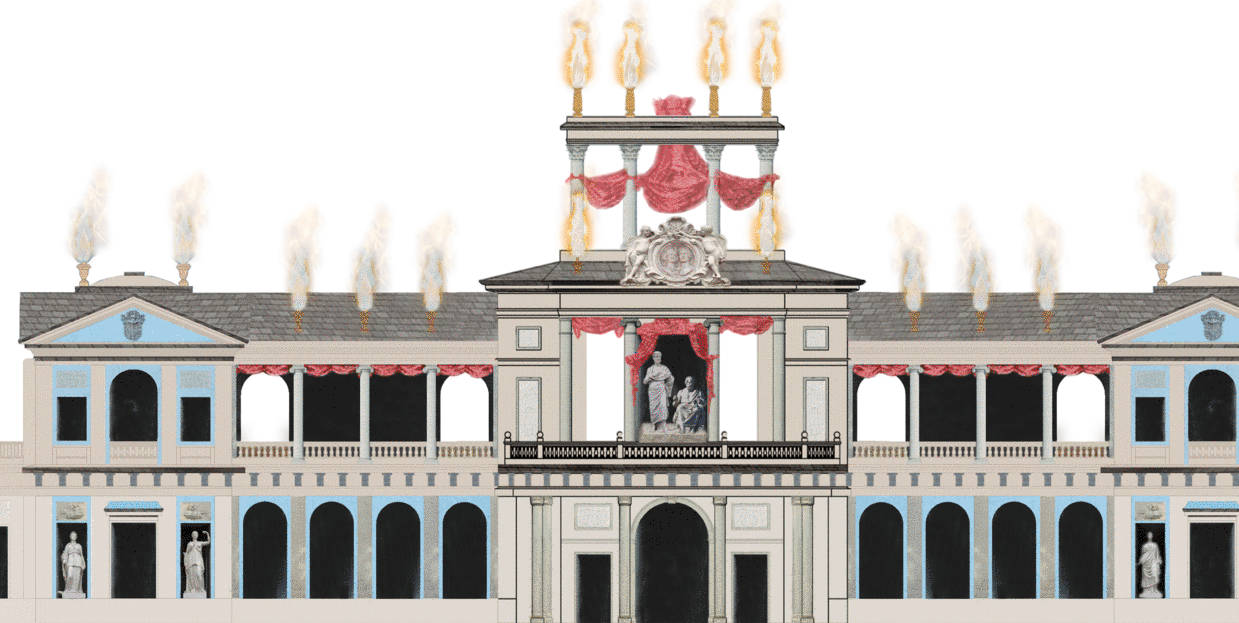
The proclamation of the new king and queen, Carlos IV and Maria Luisa de Parma took place on September 21st and 23rd, 1789 in Madrid during a particular time caught between the impulses of the French Revolution and the conservatism of enlightened despotism. However, this period was also characterized by the endeavours of an aesthetic revolution, which promoted the ideals of neoclassicism.
The festive routes around the proclamation led to the creation of ephemeral structures and decorations that embellished many streets of Madrid.
The most interesting ephemeral projects, such as painted gardens and perspectives, the stage cloths curtaining the facades of palaces, and the triumphal arches, were constructed along the route followed by the royal entourage. In fact, the route had been established centuries before, although on this occasion, the aesthetic ideals of neoclassicism influenced the city’s decorative scheme in innovative ways.
On the first day September 21st, the route followed included three streets: The Calle Mayor, the Calle de Alcalá and the Calle de Atocha, forming a triangle in the urban framework. Along this route many houses were specially adorned with ephemeral decorative elements.
On September 23rd the royal entourage followed another route by crossing the stretch that goes from the church of the Jerónimo to the Royal Palace through the Carrera of San Jerónimo.
Also on this second route a succession of ornaments and facades were erected, which adorned the core of Madrid and modified its appearance profoundly.
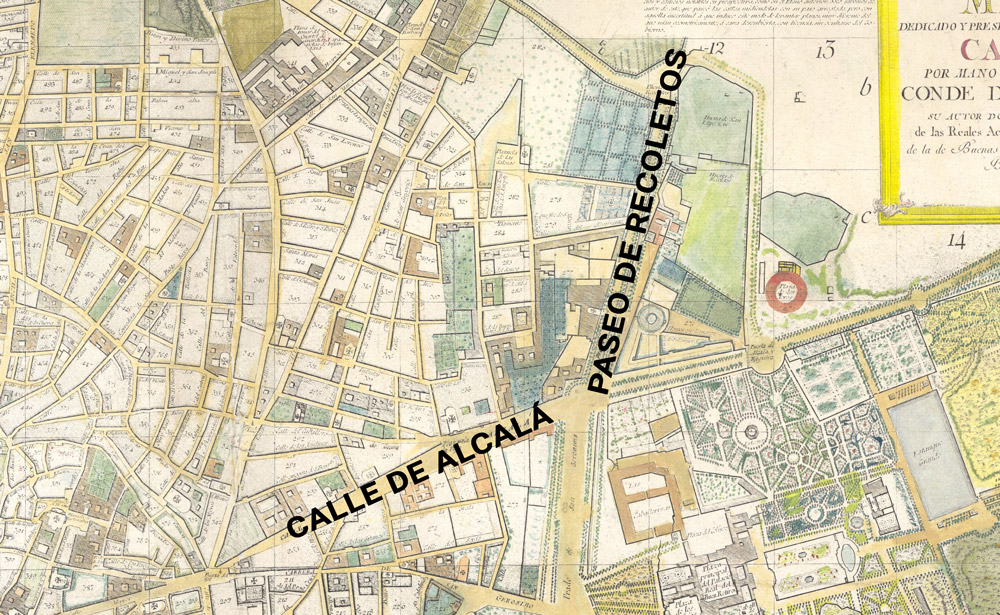
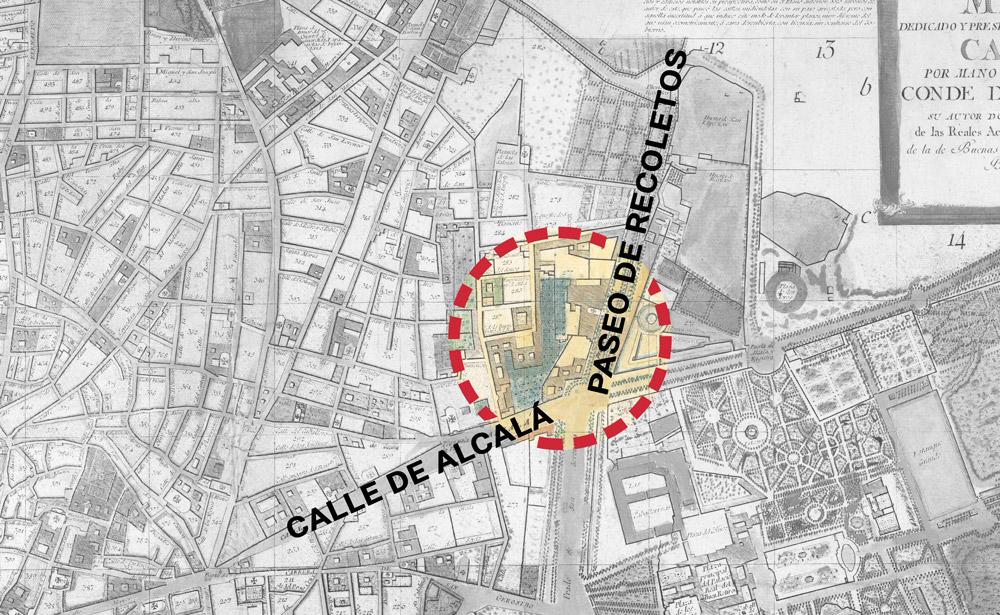
Of all the ephemeral constructions erected for the proclamation festivities of 1789, the most sophisticated was made by the architect Juan de Villanueva (1739–1811), who had become the main voice of Neoclassicism in Madrid.
It was built on the corner of the Calle de Alcalá and the Paseo de Recoletos, an area formerly belonging to the Duke of Alba. The property included a palace preceded by gardens and was very close to the royal site of the Buen Retiro and to the fountain of Cibeles.
The Ephemeral Construction of Juan de Villanueva
In the description of the ephemeral constructions or Ornatos, that was published in 1789 to perpetuate the celebration of the enthronement of Carlos IV, the example made by Juan de Villanueva is presented as an example of “good architecture, good taste and harmony.” The text describes the architecture and the ephemeral decoration as follows:
“Toda la Escultura imitaba mármol blanco [...] Todo lo demas de la obra se imitó á piedra berroqueña”
“All the sculpture imitated white marble [...] Everything else in the work imitated Berroqueña stone”
The Illumination of the Ephemeral Decoration
Another key element during the celebrations was the peculiar illumination of the facades that allowed passerby to contemplate the ephemeral constructions and ornaments also by night.
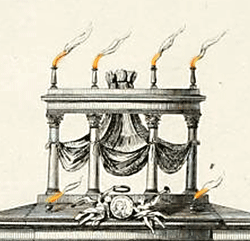
“Lo que no podemos menos de aplaudir, es la pompa de las iluminaciones; en donde no eran solo para celebradas la varia disposición de las luces de muchos colores, la grata claridad que resultaba de verse la luz y no la llama, y la gran copia de cerca de once mil vasos distribuidos en el aspecto exterior del ornato”.
“What we can not help but applaud is the pomp of the illumination; not only to celebrate the arrangements of the lights of many colours but also the pleasant clarity that resulted from seeing the light and not the flame and also the large repetition of about eleven thousand glass vessels on the surface of the ornamentation.”
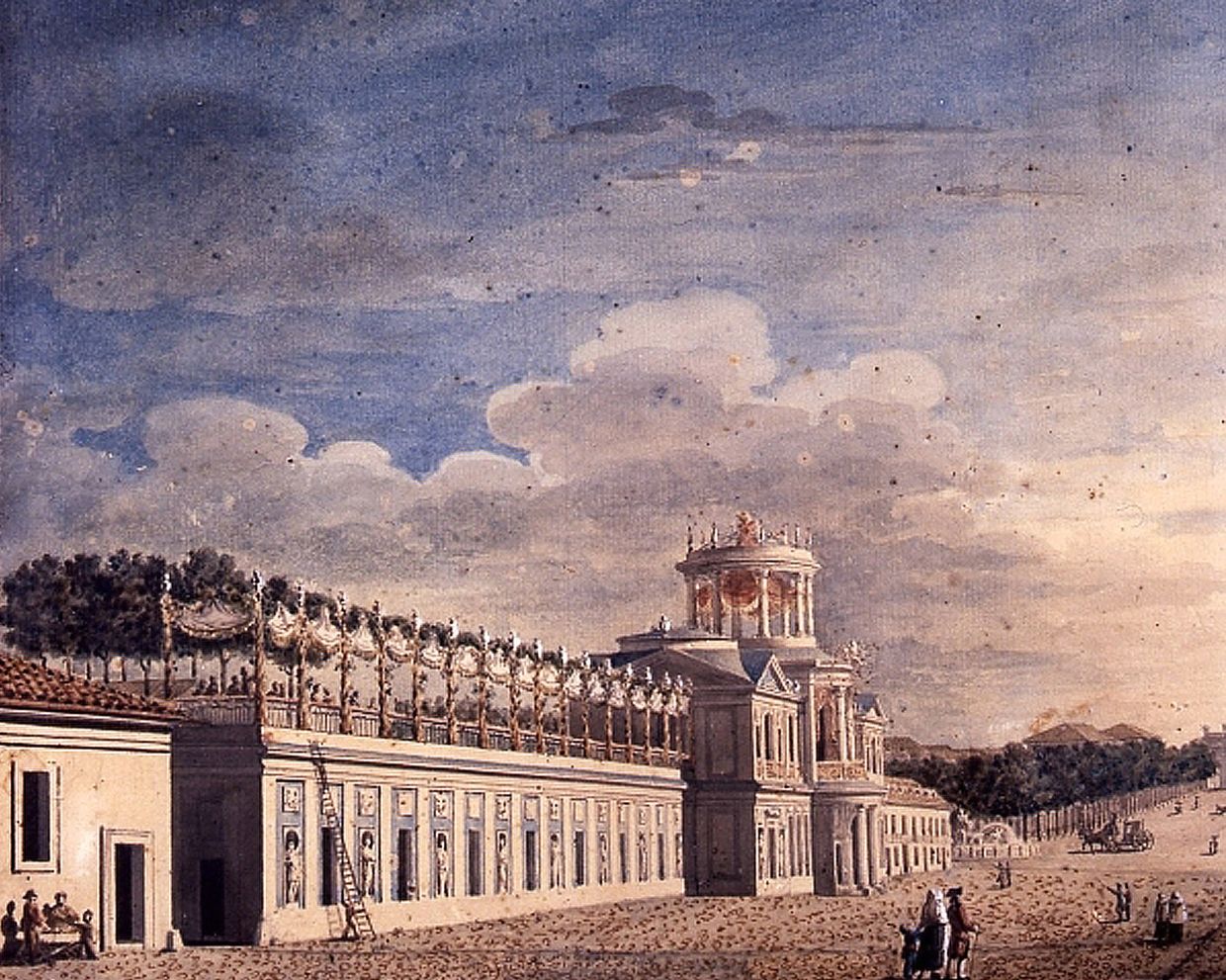
The Polychromy of the Ephemeral Decoration
Concerning the colouring of the ephemeral decoration of Juan de Villanueva there is scarce information, but it is likely that in those days of September 1789 a young disciple of Villanueva, Isidro González Velázquez (1765–1840), made some records of it painting a gouache, which he touched up and signed on the backside in 1834.
This gouache is an exceptional document allowing us to admire the external appearance of the facade of the Ornato and the colouring achieved based on marble imitation and the use of other colours in pastel shades.
According to the Description of the Ornatos, light and tempered colours characterized the ideals of “good architecture”.
Virtual Reconstruction of the Ephemeral Decoration
In order to digitize the ephemeral architecture of Juan de Villanueva and to apply an immersive, experimental colouring to it, we superimposed a “wire mesh” over the gouache of Isidro González Velázquez.
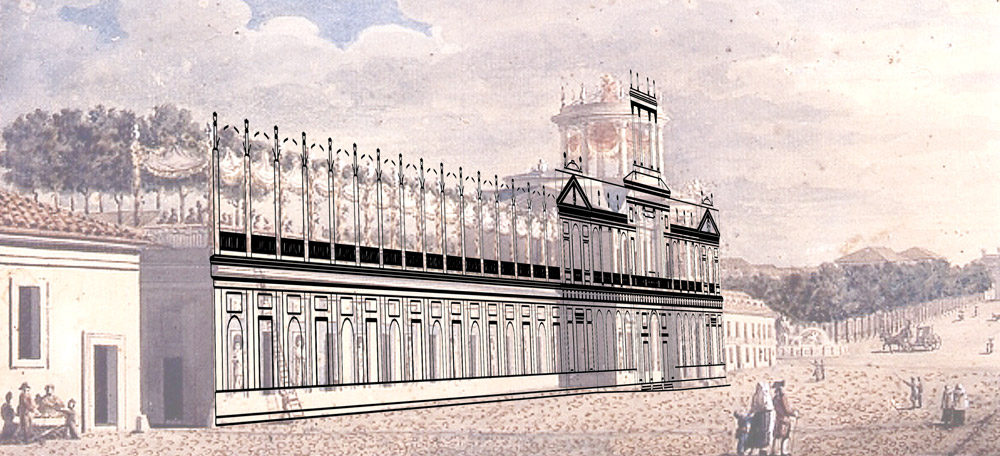
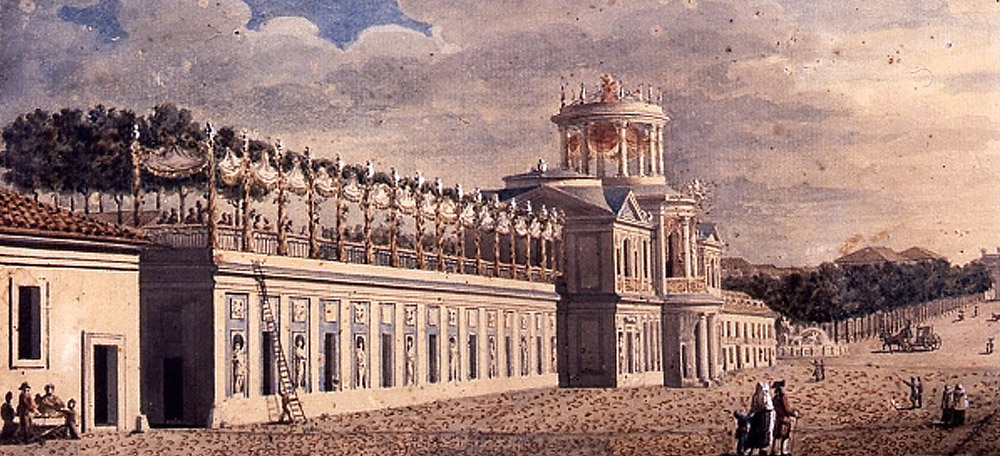

This “wire mesh” is the result of the process of vectorization of the building’s structure.
The technical process of virtual reconstruction comprises four stages:
documenting
analyzing
modelling
presenting
The process begins with a scan of the engraving, onto which an OCR technology is applied in order to establish a hierarchy within the lines and shapes that make up its geometry. The next steps are to analyze the data obtained, compare the information and define the polychrome application of the ornament. In the next step the digital reconstruction criteria (location and geometrization) are defined further within a modeling and mapping process. Once the silhouettes are obtained in 2D and 3D, it is possible to generate a “wire mesh.” A texturizing process then occurs, generating what is called “gray solids,” necessary for applying colour to the elements that make up the architecture.
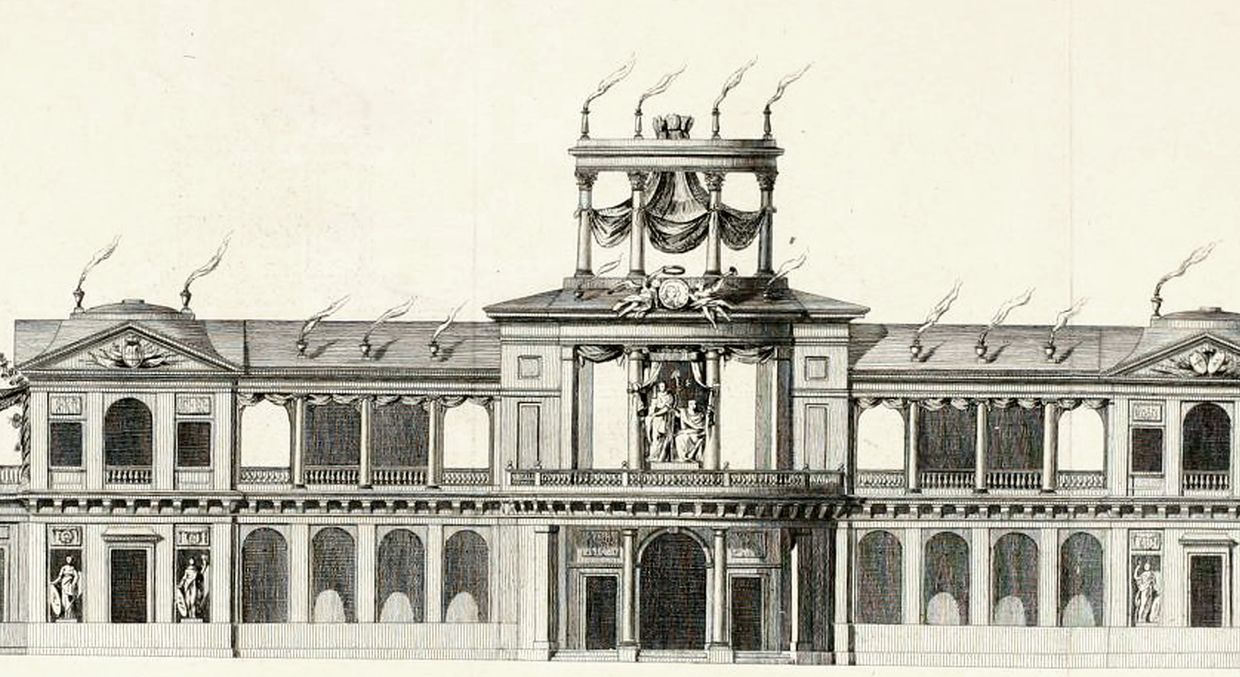
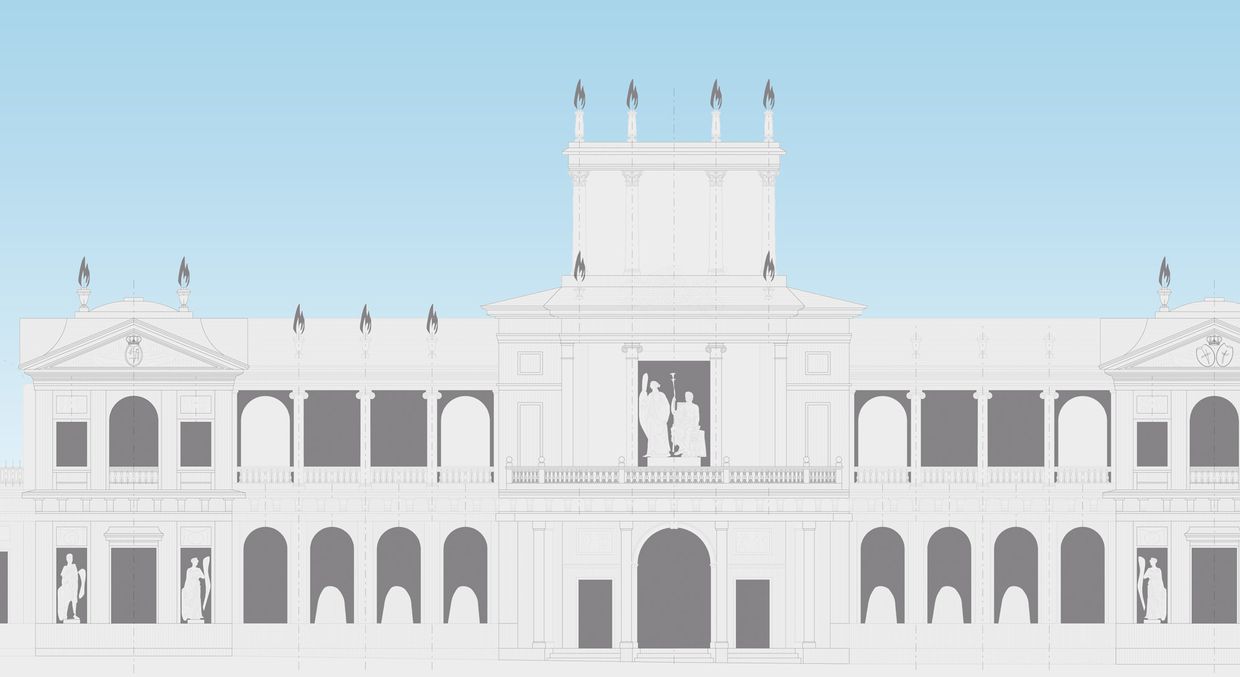
The work of Juan de Villanueva during the celebrations of 1789 exemplifies the aesthetic ideals of the buena arquitectura or “good architecture.” These ideals came to fruition throughout Madrid according to the urban reforms first introduced by Carlos III and continued by the new monarch Carlos IV.
The commissioner of the Academia de las Tres Nobles Artes de San Fernando, Josef Moreno, to whom historians attribute the Descripción de los Ornatos, praised some of these ephemeral architectural decorations and constructions, assuring that if they would be erected as real structures, that is, not as temporary artifacts, Madrid’s prestige would raise, making of it one of the preeminent capitals of Europe.
There is no doubt that the most talented artists and designers of the moment participated in this project: the best architects led by Juan de Villanueva, the best painters under the command of Francisco de Goya, who was Lieutenant Director of the Academia, and the most outstanding sculptors, helped by set designers and a large group of plasterers and other craftsmen. However, historical circumstances would halt any hopes of renovation, leaving these ephemeral constructions merely as proposals for more permanent buildings: they remained simply vestiges from a moment of elusive pomp.
Selected Bibliography
Pedro Bidagor Lasarte, "Ornatos públicos con que Madrid solemnizó la exaltación al trono de los Reyes Don Carlos IV y Doña María Luisa de Borbón", Reconstrucción, 51 (1945). 73-82.
Antonio Bonet, “La última arquitectura efímera del Antiguo Régimen”. In Los ornatos públicos de Madrid en la Coronación de Carlos IV. [Ed. Facsímil]. Gustavo Gili, Barcelona 1983.
––––– Fiesta, poder y arquitectura: aproximaciones al Barroco español. Akal, Madrid 1990.
–––––“La arquitectura efímera del Barroco”, Norba: revista de Arte, 13, (1993), 23–90.
Javier Fernández Delgado: “Política y memoria del buen gusto. Las Fiestas Reales de 1789”, Goya: Revista de arte, 181-182 (1984), 63–67.
Concepción Lopezosa Aparicio, Origen y desarrollo de un eje periférico de la capital, Paseo de Agustinos Recoletos, Paseo del Prado Viejo de San Jerónimo y Paseo de Atocha. Madrid 2004, 701–707.
––––– “Madrid: hacia la preparación del escenario cortesano”, Anales de Historia del Arte, 23 (2013), 159–169.
Pedro Moleón Gavilanes, La arquitectura de Juan de Villanueva: el proceso del proyecto. Servicio de Publicaciones del Colegio Oficial de Arquitectos, Madrid 1988.
––––– Juan de Villanueva. Akal, Madrid 1998.
––––– Isidro González Velázquez (Madrid, 1765 – Madrid, 1840). Ayuntamiento de Madrid, Madrid 2009.
––––– “Vida y obra de Juan de Villanueva: estado de la cuestión”, Boletín de Letras del Real Instituto de Estudios Asturianos, 179–180 (2012), 221–252.
José María Prados, “Isidro González Velázquez y la arquitectura efímera”, III Jornadas de Arte. Cinco siglos de arte en Madrid (XV-XX), Madrid, 1991, VV.AA, Ed. Alpuerto, Madrid 1991, 87–93.
Carlos Sambricio, La arquitectura de la Ilustración. Instituto de Estudios de Administración Local, Madrid 1986.
––––– "El problema del estilo en la arquitectura madrileña del siglo XVIII. A propósito de la una colección de dibujos de Juan de Villanueva", in Carlos Sambricio (coord.), Carlos III, Alcalde de Madrid. [Cat. Exp.] Ayuntamiento de Madrid, Madrid 1988.
Victoria Soto-Caba & Isabel Solís-Alcudia, “Virtualidad sobre estampas. Un ejemplo de Innovación Docente en el estudio del arte efímero del Antiguo Régimen. Póster”, I Simposio Nacional sobre Documentalismo del Patrimonio Histórico y Medioambiental (SIDOP): La imagen del Patrimonio: Fotografía y Documentalismo, Granada 2017.
––––– “Temporary polychrome: Colour Digitization of the Ornamentation for Carlos IV’s Entry into Madrid, 1789”, in Cities in the Digital Age. Exploring past, present and future, coord. A. Gago da Cámara et alt. CITCEM, Porto 2018. 63–82.
